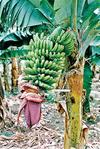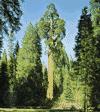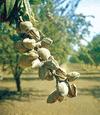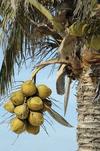Plants
Plantae any multicellular eukaryotic life form characterized by (1) photosynthetic nutrition (a characteristic possessed by all plants except some parasitic plants and underground orchids), in which chemical...
Browse Subcategories:
Displaying Featured Plants Articles
-
 Charles DarwinEnglish naturalist whose scientific theory of evolution by natural selection became the foundation of modern evolutionary studies. An affable country gentleman, Darwin at first shocked religious Victorian society by suggesting that animals and humans shared a common ancestry. However, his nonreligious biology appealed to the rising class of professional...
Charles DarwinEnglish naturalist whose scientific theory of evolution by natural selection became the foundation of modern evolutionary studies. An affable country gentleman, Darwin at first shocked religious Victorian society by suggesting that animals and humans shared a common ancestry. However, his nonreligious biology appealed to the rising class of professional... -
 Nikolay Ivanovich VavilovSoviet plant geneticist whose research into the origins of cultivated plants incurred the animosity of T.D. Lysenko, official spokesman for Soviet biology in his time. Vavilov studied under William Bateson, founder of the science of genetics, at the University of Cambridge and the John Innes Horticultural Institution in London (1913–14). Returning...
Nikolay Ivanovich VavilovSoviet plant geneticist whose research into the origins of cultivated plants incurred the animosity of T.D. Lysenko, official spokesman for Soviet biology in his time. Vavilov studied under William Bateson, founder of the science of genetics, at the University of Cambridge and the John Innes Horticultural Institution in London (1913–14). Returning... -
 okra(Hibiscus, or Abelmoschus, esculentus), herbaceous, hairy, annual plant of the mallow family (Malvaceae). It is native to the tropics of the Eastern Hemisphere and is widely cultivated or naturalized in the tropics and subtropics of the Western Hemisphere for its edible fruit. The leaves are heart-shaped and three- to five-lobed; the flowers are yellow...
okra(Hibiscus, or Abelmoschus, esculentus), herbaceous, hairy, annual plant of the mallow family (Malvaceae). It is native to the tropics of the Eastern Hemisphere and is widely cultivated or naturalized in the tropics and subtropics of the Western Hemisphere for its edible fruit. The leaves are heart-shaped and three- to five-lobed; the flowers are yellow... -
 quinoaChenopodium quinoa plant species grown for its tiny edible seeds. As a member of the Amaranthaceae family, quinoa is not a true cereal. Its seeds are high in protein and fibre, and its young leaves are also nutritious and can be eaten as a vegetable similar to spinach (to which it is related). The plant is native to the Andean region of South America,...
quinoaChenopodium quinoa plant species grown for its tiny edible seeds. As a member of the Amaranthaceae family, quinoa is not a true cereal. Its seeds are high in protein and fibre, and its young leaves are also nutritious and can be eaten as a vegetable similar to spinach (to which it is related). The plant is native to the Andean region of South America,... -
 bananafruit of the genus Musa, of the family Musaceae, one of the most-important fruit crops of the world. The banana is grown in the tropics, and, though it is most widely consumed in those regions, it is valued worldwide for its flavour, nutritional value, and availability throughout the year. A ripe fruit contains as much as 22 percent of carbohydrate,...
bananafruit of the genus Musa, of the family Musaceae, one of the most-important fruit crops of the world. The banana is grown in the tropics, and, though it is most widely consumed in those regions, it is valued worldwide for its flavour, nutritional value, and availability throughout the year. A ripe fruit contains as much as 22 percent of carbohydrate,... -
 potatoSolanum tuberosum annual plant in the nightshade family (Solanaceae), grown for its starchy edible tubers. The potato is native to the Peruvian-Bolivian Andes and is one of the world’s main food crops. Potatoes are frequently served whole or mashed as a cooked vegetable and are also ground into potato flour, used in baking and as a thickener for sauces....
potatoSolanum tuberosum annual plant in the nightshade family (Solanaceae), grown for its starchy edible tubers. The potato is native to the Peruvian-Bolivian Andes and is one of the world’s main food crops. Potatoes are frequently served whole or mashed as a cooked vegetable and are also ground into potato flour, used in baking and as a thickener for sauces.... -
 photosynthesisthe process by which green plants and certain other organisms transform light energy into chemical energy. During photosynthesis in green plants, light energy is captured and used to convert water, carbon dioxide, and minerals into oxygen and energy-rich organic compounds. It would be impossible to overestimate the importance of photosynthesis in the...
photosynthesisthe process by which green plants and certain other organisms transform light energy into chemical energy. During photosynthesis in green plants, light energy is captured and used to convert water, carbon dioxide, and minerals into oxygen and energy-rich organic compounds. It would be impossible to overestimate the importance of photosynthesis in the... -
 weedgeneral term for any plant growing where it is not wanted. Ever since humans first attempted the cultivation of plants, they have had to fight the invasion by weeds into areas chosen for crops. Some unwanted plants later were found to have virtues not originally suspected and so were removed from the category of weeds and taken under cultivation. Other...
weedgeneral term for any plant growing where it is not wanted. Ever since humans first attempted the cultivation of plants, they have had to fight the invasion by weeds into areas chosen for crops. Some unwanted plants later were found to have virtues not originally suspected and so were removed from the category of weeds and taken under cultivation. Other... -
 mistletoeany of many species of parasitic plants of the families Loranthaceae, Misodendraceae, and Santalaceae, especially those of the genera Viscum, Phoradendron, and Arceuthobium (all of which are members of the family Santalaceae). Most mistletoes parasitize a variety of hosts, and some species even parasitize other mistletoes, which in turn are parasitic...
mistletoeany of many species of parasitic plants of the families Loranthaceae, Misodendraceae, and Santalaceae, especially those of the genera Viscum, Phoradendron, and Arceuthobium (all of which are members of the family Santalaceae). Most mistletoes parasitize a variety of hosts, and some species even parasitize other mistletoes, which in turn are parasitic... -
 riceedible starchy cereal grain and the plant by which it is produced. Roughly one-half of the world population, including virtually all of East and Southeast Asia, is wholly dependent upon rice as a staple food; 95 percent of the world’s rice crop is eaten by humans. The cultivated rice plant, Oryza sativa, is an annual grass of the Gramineae family....
riceedible starchy cereal grain and the plant by which it is produced. Roughly one-half of the world population, including virtually all of East and Southeast Asia, is wholly dependent upon rice as a staple food; 95 percent of the world’s rice crop is eaten by humans. The cultivated rice plant, Oryza sativa, is an annual grass of the Gramineae family.... -
 cornZea mays cereal plant of the grass family (Poaceae) and its edible grain. The domesticated crop originated in the Americas and is one of the most widely distributed of the world’s food crops. Corn is used as livestock feed, as human food, as biofuel, and as raw material in industry. In the United States the colourful variegated strains known as Indian...
cornZea mays cereal plant of the grass family (Poaceae) and its edible grain. The domesticated crop originated in the Americas and is one of the most widely distributed of the world’s food crops. Corn is used as livestock feed, as human food, as biofuel, and as raw material in industry. In the United States the colourful variegated strains known as Indian... -
 turmeric(Curcuma longa), perennial herbaceous plant of the ginger family (Zingiberaceae), the tuberous rhizomes, or underground stems, of which have been used from antiquity as a condiment, a textile dye, and medically as an aromatic stimulant. In biblical times it was used as a perfume as well as a spice. In the Middle Ages it was called Indian saffron because...
turmeric(Curcuma longa), perennial herbaceous plant of the ginger family (Zingiberaceae), the tuberous rhizomes, or underground stems, of which have been used from antiquity as a condiment, a textile dye, and medically as an aromatic stimulant. In biblical times it was used as a perfume as well as a spice. In the Middle Ages it was called Indian saffron because... -
 persimmoneither of two trees of the genus Diospyros (family Ebenaceae) and their globular, edible fruits. The Oriental persimmon (D. kaki), an important and extensively grown fruit in China and Japan, where it is known as kaki, was introduced into France and other Mediterranean countries in the 19th century and grown to a limited extent there. Introduced into...
persimmoneither of two trees of the genus Diospyros (family Ebenaceae) and their globular, edible fruits. The Oriental persimmon (D. kaki), an important and extensively grown fruit in China and Japan, where it is known as kaki, was introduced into France and other Mediterranean countries in the 19th century and grown to a limited extent there. Introduced into... -
 wheatany of several species of cereal grasses of the genus Triticum (family Poaceae) and their edible grains. Wheat is one of the oldest and most important of the cereal crops. Of the thousands of varieties known, the most important are common wheat (Triticum aestivum), used to make bread; durum wheat (T. durum), used in making pasta (alimentary pastes)...
wheatany of several species of cereal grasses of the genus Triticum (family Poaceae) and their edible grains. Wheat is one of the oldest and most important of the cereal crops. Of the thousands of varieties known, the most important are common wheat (Triticum aestivum), used to make bread; durum wheat (T. durum), used in making pasta (alimentary pastes)... -
 cannabisCannabis plant belonging to the family Cannabaceae of the nettle order (Urticales). By some classifications, the genus Cannabis comprises a single species, hemp (C. sativa), a stout, aromatic, erect annual herb that originated in Central Asia and is now cultivated worldwide, including in Europe, southern Asia, the Middle East, India, Africa, and the...
cannabisCannabis plant belonging to the family Cannabaceae of the nettle order (Urticales). By some classifications, the genus Cannabis comprises a single species, hemp (C. sativa), a stout, aromatic, erect annual herb that originated in Central Asia and is now cultivated worldwide, including in Europe, southern Asia, the Middle East, India, Africa, and the... -
 orangeany of several species of small trees or shrubs of the genus Citrus of the family Rutaceae and their nearly round fruits, which have leathery and oily rinds and edible, juicy inner flesh. A number of species and varieties of orange are economically important, namely the China orange, also called the sweet, or common, orange (Citrus × sinensis); the...
orangeany of several species of small trees or shrubs of the genus Citrus of the family Rutaceae and their nearly round fruits, which have leathery and oily rinds and edible, juicy inner flesh. A number of species and varieties of orange are economically important, namely the China orange, also called the sweet, or common, orange (Citrus × sinensis); the... -
 tomatoSolanum lycopersicum flowering plant of the nightshade family (Solanaceae), cultivated extensively for its edible fruits. Labelled as a vegetable for nutritional purposes, tomatoes are a good source of vitamin C and the phytochemical lycopene. The fruits are commonly eaten raw in salads, served as a cooked vegetable, used as an ingredient of various...
tomatoSolanum lycopersicum flowering plant of the nightshade family (Solanaceae), cultivated extensively for its edible fruits. Labelled as a vegetable for nutritional purposes, tomatoes are a good source of vitamin C and the phytochemical lycopene. The fruits are commonly eaten raw in salads, served as a cooked vegetable, used as an ingredient of various... -
 roseRosa genus of some 100 species of perennial shrubs in the rose family (Rosaceae). Roses are native primarily to the temperate regions of the Northern Hemisphere. Many roses are cultivated for their beautiful flowers, which range in colour from white through various tones of yellow and pink to dark crimson and maroon, and most have a delightful fragrance,...
roseRosa genus of some 100 species of perennial shrubs in the rose family (Rosaceae). Roses are native primarily to the temperate regions of the Northern Hemisphere. Many roses are cultivated for their beautiful flowers, which range in colour from white through various tones of yellow and pink to dark crimson and maroon, and most have a delightful fragrance,... -
 poinsettia(Euphorbia pulcherrima), best known member of the diverse spurge family, Euphorbiaceae. The poinsettia is native to Mexico and Central America, where it grows in moist, wet, wooded ravines and on rocky hillsides. It was named for Joel R. Poinsett, who popularized the plant and introduced it to floriculture while he was U.S. minister to Mexico in the...
poinsettia(Euphorbia pulcherrima), best known member of the diverse spurge family, Euphorbiaceae. The poinsettia is native to Mexico and Central America, where it grows in moist, wet, wooded ravines and on rocky hillsides. It was named for Joel R. Poinsett, who popularized the plant and introduced it to floriculture while he was U.S. minister to Mexico in the... -
 blackberryusually prickly fruit-bearing bush of the genus Rubus of the rose family (Rosaceae), known for its dark edible fruits. Native chiefly to north temperate regions, wild blackberries are particularly abundant in eastern North America and on the Pacific coast of that continent and are cultivated in many areas of North America and Europe. Blackberries are...
blackberryusually prickly fruit-bearing bush of the genus Rubus of the rose family (Rosaceae), known for its dark edible fruits. Native chiefly to north temperate regions, wild blackberries are particularly abundant in eastern North America and on the Pacific coast of that continent and are cultivated in many areas of North America and Europe. Blackberries are... -
 plantPlantae any multicellular eukaryotic life form characterized by (1) photosynthetic nutrition (a characteristic possessed by all plants except some parasitic plants and underground orchids), in which chemical energy is produced from water, minerals, and carbon dioxide with the aid of pigments and the radiant energy of the Sun, (2) essentially unlimited...
plantPlantae any multicellular eukaryotic life form characterized by (1) photosynthetic nutrition (a characteristic possessed by all plants except some parasitic plants and underground orchids), in which chemical energy is produced from water, minerals, and carbon dioxide with the aid of pigments and the radiant energy of the Sun, (2) essentially unlimited... -
 pomegranatefruit of Punica granatum, a bush or small tree of Asia, which with a little-known species from the island of Socotra constitutes the family Punicaceae. The plant, which may attain 5 or 7 metres (16 or 23 feet) in height, has elliptic to lance-shaped, bright-green leaves about 75 millimetres (3 inches) long and handsome axillary orange-red flowers borne...
pomegranatefruit of Punica granatum, a bush or small tree of Asia, which with a little-known species from the island of Socotra constitutes the family Punicaceae. The plant, which may attain 5 or 7 metres (16 or 23 feet) in height, has elliptic to lance-shaped, bright-green leaves about 75 millimetres (3 inches) long and handsome axillary orange-red flowers borne... -
 avocadofruit of Persea americana of the family Lauraceae, a tree native to the Western Hemisphere from Mexico south to the Andean regions. Avocado fruits have greenish or yellowish flesh with a buttery consistency and a rich, nutty flavour. They are often eaten in salads, and in many parts of the world they are eaten as a dessert. Mashed avocado is the principal...
avocadofruit of Persea americana of the family Lauraceae, a tree native to the Western Hemisphere from Mexico south to the Andean regions. Avocado fruits have greenish or yellowish flesh with a buttery consistency and a rich, nutty flavour. They are often eaten in salads, and in many parts of the world they are eaten as a dessert. Mashed avocado is the principal... -
 peanutArachis hypogaea legume of the pea family (Fabaceae), grown for its edible seeds. Native to tropical South America, the peanut was at an early time introduced to the Old World tropics. The seeds are a nutritionally dense food, rich in protein and fat. Despite its several common names, the peanut is not a true nut. As with other legumes, the plant adds...
peanutArachis hypogaea legume of the pea family (Fabaceae), grown for its edible seeds. Native to tropical South America, the peanut was at an early time introduced to the Old World tropics. The seeds are a nutritionally dense food, rich in protein and fat. Despite its several common names, the peanut is not a true nut. As with other legumes, the plant adds... -
 treewoody plant that regularly renews its growth (perennial). Most plants classified as trees have a single self-supporting trunk containing woody tissues, and in most species the trunk produces secondary limbs, called branches. To many, the word tree evokes images of such ancient, powerful, and majestic structures as oaks and sequoias, the latter being...
treewoody plant that regularly renews its growth (perennial). Most plants classified as trees have a single self-supporting trunk containing woody tissues, and in most species the trunk produces secondary limbs, called branches. To many, the word tree evokes images of such ancient, powerful, and majestic structures as oaks and sequoias, the latter being... -
 almondPrunus dulcis tree native to southwestern Asia and its edible seed. A member of the family Rosaceae (order Rosales), Prunus dulcis is an economically important crop tree grown primarily in Mediterranean climates between 28° and 48° N and between 20° and 40° S, with California producing nearly 80 percent of the world’s supply. There are two varieties,...
almondPrunus dulcis tree native to southwestern Asia and its edible seed. A member of the family Rosaceae (order Rosales), Prunus dulcis is an economically important crop tree grown primarily in Mediterranean climates between 28° and 48° N and between 20° and 40° S, with California producing nearly 80 percent of the world’s supply. There are two varieties,... -
 mangoMangifera indica member of the cashew family (Anacardiaceae), one of the most important and widely cultivated fruits of the tropical world and the tree on which it grows, considered indigenous to eastern Asia, Myanmar (Burma), and Assam state of India. The tree is evergreen, often reaching 15–18 metres (50–60 feet) in height and attaining great age....
mangoMangifera indica member of the cashew family (Anacardiaceae), one of the most important and widely cultivated fruits of the tropical world and the tree on which it grows, considered indigenous to eastern Asia, Myanmar (Burma), and Assam state of India. The tree is evergreen, often reaching 15–18 metres (50–60 feet) in height and attaining great age.... -
 chickpeaCicer arietinum annual plant of the pea family (Fabaceae), widely grown for its nutritious seeds. Chickpeas are an important food plant in India, Africa, and Central and South America. Hummus (or hummous)—chickpeas mashed to a paste with lemon juice, olive oil, and tahini (sesame paste)—is widely eaten in the Middle East as a sauce and dip for bread....
chickpeaCicer arietinum annual plant of the pea family (Fabaceae), widely grown for its nutritious seeds. Chickpeas are an important food plant in India, Africa, and Central and South America. Hummus (or hummous)—chickpeas mashed to a paste with lemon juice, olive oil, and tahini (sesame paste)—is widely eaten in the Middle East as a sauce and dip for bread.... -
 coconut palmtree of the palm family (Arecaceae). It is one of the most important crops of the tropics. The slender, leaning, ringed trunk of the tree rises to a height of up to 25 m (80 feet) from a swollen base and is surmounted by a graceful crown of giant, featherlike leaves. Mature fruits, ovoid or ellipsoid in shape, 300–450 mm (12–18 inches) in length, and...
coconut palmtree of the palm family (Arecaceae). It is one of the most important crops of the tropics. The slender, leaning, ringed trunk of the tree rises to a height of up to 25 m (80 feet) from a swollen base and is surmounted by a graceful crown of giant, featherlike leaves. Mature fruits, ovoid or ellipsoid in shape, 300–450 mm (12–18 inches) in length, and... -
 gingerZingiber officinale herbaceous perennial plant of the family Zingiberaceae, probably native to southeastern Asia, or its aromatic, pungent rhizome (underground stem) used as a spice, flavouring, food, and medicine. Its generic name Zingiber is derived from the Greek zingiberis, which comes from the Sanskrit name of the spice, singabera. Its use in...
gingerZingiber officinale herbaceous perennial plant of the family Zingiberaceae, probably native to southeastern Asia, or its aromatic, pungent rhizome (underground stem) used as a spice, flavouring, food, and medicine. Its generic name Zingiber is derived from the Greek zingiberis, which comes from the Sanskrit name of the spice, singabera. Its use in...

